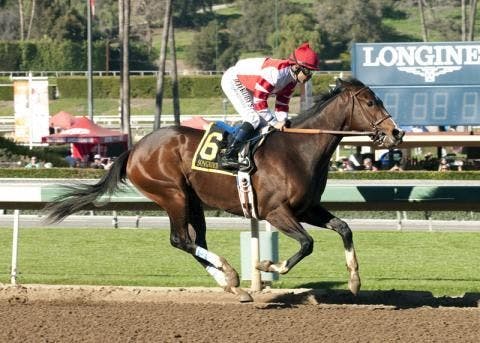Santa Ysabel a race unworthy of a Songbird

Coming off an undefeated championship campaign where she was hailed as arguably the best of her generation regardless of sex, followed by a blowout win in the $300,000 Las Virgenes (G2) in her season opener, the last thing I expected the connections of Songbird to do was toss her into a Grade 3 throwaway worth a measly $100,000. Waiting for the $400,000 Santa Anita Oaks (G1) on April 9, as a final prep for the May 6 Kentucky Oaks (G1), seemed like a proper course of action.
It's a cliché that horsemen hate hearing from "armchair trainers" about how they should handle their horse. The connections of Songbird, in particular, have had to quelch pleadings from a vocal segment of the filly's fan base that she should be pointed for the Kentucky Derby (G1) rather than stay on the path toward the Oaks.
While most armchair trainers, of which I am one from time to time (I wouldn't be human if I wasn't), generally have their strongest opinions on where a horse should run, some of us are also known to take a view on where they should not. Examples from my own past were Princess of Sylmar in the 2013 Breeders' Cup Distaff (G1) and American Pharoah in last year's Travers (G1).
"There are a progression of races that you run in to get to the [Kentucky Oaks]," trainer Jerry Hollendorfer said Sunday. "You have the first one [Las Virgenes], then this one [Santa Ysabel], then the Santa Anita Oaks."
Perhaps "sequence of races" would be a more accurate phrase. By any measure, there is nothing progressive about going from the Las Virgenes to the Santa Ysabel. In all honesty, it's a regression.
The Las Virgenes is a younger race than the Santa Ysabel, but achieved significant status within a couple years of its inauguration in 1984. It's even carried Grade 1 ranking for most of its existence. There have been so many notable winners of this event, it would be tedious to list some of them here.
The Santa Ysabel was created in 1968, and until 1996 was run with restricted conditions that made it ineligible for grading. There were certainly some nice winners in its restricted days -- Cathy Honey, Miss Musket, Ski Goggle, Jeanne Jones, and Gorgeous all went on to do good things -- and even more since it became a Grade 3 event in 1998. However, its prestige pales in comparison to the Las Virgenes.
Other than to keep Songbird from tearing down the barn for five weeks, there is nothing really to be gained, financially or otherwise, by entering her in the Santa Ysabel. There is, however, risk -- always inherent -- and from this view it seems to outweigh any potential benefits.
Perhaps the bigger question is why the Santa Ysabel was hemmed in between the Las Virgenes and Santa Anita Oaks at all. The Las Virgenes has been the main lead-in to the Santa Anita Oaks as long as I've followed the sport, and yet it was seemingly scheduled earlier in the year to add a bit more punch to a February 6 card that already included the San Antonio (G2), San Marcos (G2), and Robert B. Lewis (G3).
If Songbird had started out in the Santa Ysabel and was running this weekend in the Las Virgenes, all of this would make more sense. As it is, running for a mere $60,000 first-place check when more prestigious and lucrative races lie ahead seems to be putting the cart before the horse.
(Benoit Photos)
ADVERTISEMENT



